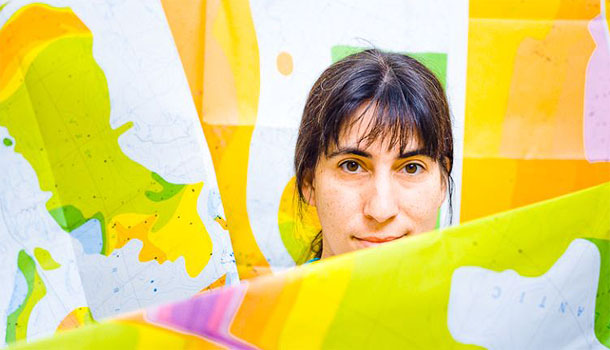
Emily Brodsky
Earth and Planetary Sciences
Santa Cruz
When she was a Harvard freshman, Emily Brodsky was majoring in math, but something wasn’t clicking. When summer finally arrived, she headed west. Brodsky found the Grand Canyon of the Yellowstone, a 24-mile gorge of volcanic quartz, feldspar, mica, granites, lavas, basalts and crystals. From her high perch on Inspiration Point, sheer canyon walls dropped more than a thousand feet and the Yellowstone River crested a high rock saddle, a thick white curtain plunging into a series of three cascades.
When she returned to Boston, Brodsky knocked at every office door in the Earth sciences building, determined to find a professor to become her advisor. She struck out until she reached the very last door.
“That door said yes,” she says wryly.
Today, Brodsky, professor of Earth and planetary sciences at UC Santa Cruz, is regarded as one of the most promising researchers into the physics of earthquakes, with “sidelines” in volcanoes and glaciers. The Seismological Society of America recognized her with their inaugural 2005 Charles Richter Early Career award, and last year the National Science Foundation selected her as a lecturer in their prestigious “Voices from the Future” series.
Brodsky’s current effort is a large-scale, international deepwater drilling project to investigate the causes of the March 11 earthquake and tsunami in Tohuku, Japan.
Question:
The magnitude of the Tohuku earthquake and tsunami in Japan was unexpected, despite the abundance of seismometers and top scientists there. People also underestimated other recent big earthquakes around the world. Is earthquake prediction possible?
Answer:
It’s true that people didn’t think a magnitude 9 could come off the Japan coast. After Tohuku, we realized that we needed to think about how we were going about things. One approach was to go back to basic science, the basic physics of earthquakes. That means looking at the forces that operate on the faults.
Question:
Was that the motivation for your deepwater drilling project?
Answer:
Yes. We wanted to look at the rock in a place that slipped the most. We want to try to measure these forces.
Question:
How do you do that? The earthquake is over, is it not?
Answer:
What we do is take the temperature of the fault. When the fault resists, the friction heats up the rock. It takes a while to cool down, so even though we’ll be drilling a year later, by measuring how much the fault heated up, we’ll gather a lot of the information.
A year doesn’t sound rapid to people, but it’s the fastest it’s ever been done. We have very large ships that are committed to a number of scientific projects decades out.
Question:
The technicians will be drilling undersea, and then into rock. How deep do they have to drill?
Answer:
Seven kilometers. Nobody has ever drilled a substantive hole that far down before. We have one site and we’ll be drilling two holes. It’s a big deal. This is a major international collaboration, with funding from a number of countries including the United States and Japan.
Question:
When does it start?
Answer:
The project starts April 1, 2012. We’ve scheduled 48 days of drilling. The vessel is called the Chikyu. It’s a Japanese vessel designed to do scientific drilling in the water. One of its thrusters actually was damaged in the tsunami, but it will be repaired by early 2012.
Question:
With all the research that already has been done, why is it still so difficult to predict earthquakes?
Answer:
We have made enormous progress in a number of areas. We understand the kinds of seismic waves that earthquakes make. We’ve made huge progress in engineering for earthquake zones. It’s actually pretty important that the buildings stood up in Tokyo. There was huge tsunami damage but not as much from the earthquake, partly because Japan has done such a great job at engineering buildings.
Question:
I was struck by graphics that showed a huge increase in seismometers.
Answer:
Earthscope, a project to improve the geophysical instrumentation in the U.S., has opened our eyes. We’ve learned that an earthquake in one place can trigger earthquakes somewhere else, and that is entirely due to the massive increase in seismometer density over the last 20 years.
Question:
Here is the cocktail party question: When can we expect a big quake closer to home, on the San Andreas Fault?
Answer:
We expect a major San Andreas event any day now. We anticipate rupturing from the Mexican border all the way up through Riverside. The Southern California Earthquake Center, which has many UC members, has been simulating various events and funneling this information to planners.
Question:
You often talk about using science to benefit society. Is this a priority for you?
Answer:
I think all of us who study earthquakes are trying to save lives. It’s a long road, connecting the dots, using basic science to save people’s lives. Sometimes it seems despairingly far away.
Question:
You seem to have a real love for landscape, too. Did you fall in the love with the American West?
Answer:
I think so. Yellowstone was that transformative moment. Once I started studying earthquakes, there was no turning back. The earth moves here. It’s more interesting, and a phenomenal amount of expertise is located here in the University of California system. We’re a global resource.
Question:
Is being outdoors the best part of your job?
Answer:
Actually, the best part of my job is advising students. Science is done by people. A student’s experiences inform what he or she does in science. It is a wonderful thing to watch that process unfold. You can change somebody’s life.
Question:
Like the person behind that last door in the earth sciences building changed yours?
Answer:
Exactly.